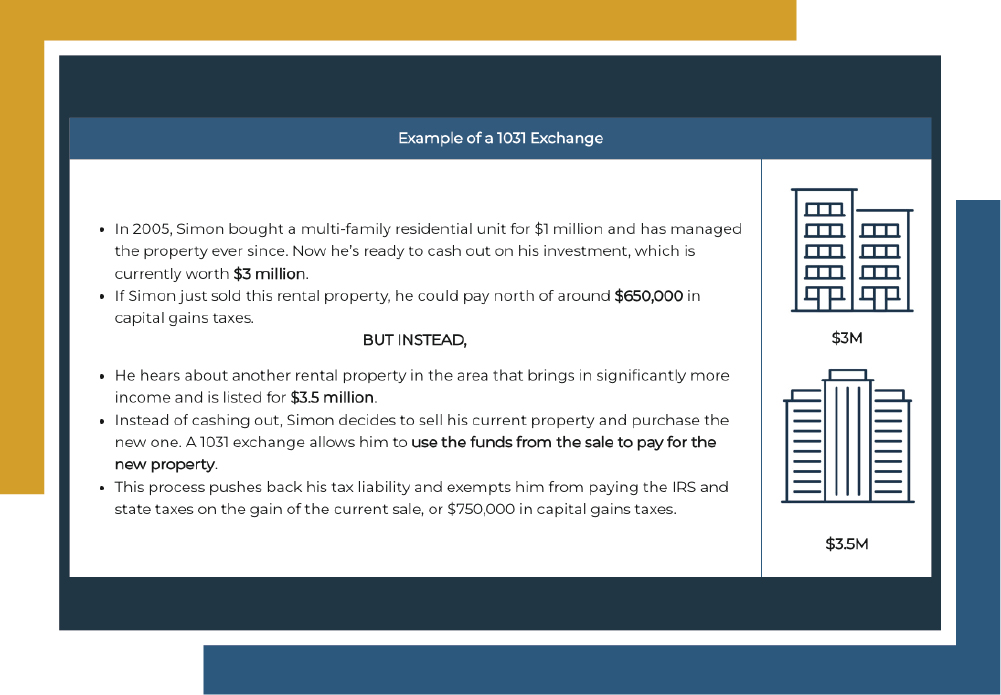While investing can be a rewarding experience, venturing into new financial waters can bring on feelings of anxiety. Despite the learning curve, most investors still want some kind of reassurance that they’re making the best moves — especially when you have so many options.
Another concern of financial ventures is the fact that at some point, Uncle Sam will come for his share. Taxes are typically as unavoidable as, well, — death and taxes, when it comes to real estate investments.
If you’re a landlord or property manager, you’re probably already aware of this fact because all the net income your property generates counts as taxable income. This small — but vital — detail can add to an already lengthy list of nagging deadlines. On top of all the duties, responsibilities, and expenditures of managing real estate property, paying taxes on it may feel like an added insult when you finally have an opportunity to sell.
This is why the tax break from a 1031 exchange has become an increasingly attractive option for new investors and real estate managers. If you’re a California resident who wants to explore real estate opportunities in other states, you may be wondering if a 1031 exchange from California to another state is even possible. The short answer is that it is.
Below, we’ll answer that question in greater detail — and we’ll offer a baseline explanation of a 1031 exchange, including some guidelines and restrictions.
1031 Exchange in a Nutshell
 If you’ve ever sold an investment property, you know you’re responsible for paying capital gains taxes on any profit you make from the sale. But did you know there’s a way to defer those taxes?
If you’ve ever sold an investment property, you know you’re responsible for paying capital gains taxes on any profit you make from the sale. But did you know there’s a way to defer those taxes?
A 1031 exchange, named for Section 1031 of the Internal Revenue Code (IRC), refers to the practice of swapping one real estate property for another to delay (or “defer”) the required payment of capital gains taxes.
This tax break applies when you sell a property that’s used explicitly for investment purposes and purchase another, “like-kind” investment property of equal or greater value. This transaction essentially negates your need to pay taxes on capital gains for your transaction.
For example, if you purchased an investment property for $150,000 and sold it for $300,000 five years later, you may be on the hook for around $50,000+ in federal/state capital gains taxes — that’s nearly a third of the profits you made.
| Example of a 1031 Exchange | |
BUT INSTEAD,
|
$3.5M |
You can see how skipping this last step of the property sales process might seem attractive to investors. And, when done correctly, this practice can be used in perpetuity. While 1031 exchanges are a great way to defer capital gains taxes, you should know about some of the guidelines and strict timelines that apply.
1031 Exchange Rules
One of the most important things to note concerning a 1031 exchange is that proceeds from the sale cannot be received by the seller. That means that when you sell your property, the funds must be handled by an accommodator (sometimes called an intermediary) or the 1031 exchange will be null.
Also, when engaging in a 1031 exchange, there is a rather tight window during which the process must be completed.
- 45-Day Rule: When the sale of your property is complete, you need to designate the replacement property and communicate it in writing to the accommodator within 45 days.
- 180 Day-Rule: Once you have decided on your property and notified the intermediary you intend to close on it, you must complete the transaction within 180 days of the sale of your previous property.
It is also crucial to understand that these two time periods run synchronously. That means if you notify an intermediary of your new property 30 days after your first sale, you now have 150 days to close on that property (180 minus 30).
How a 1031 Exchange from California to Another State Works
For those living in California, the prospect of selling high-priced West Coast real estate and purchasing something in an entirely different state may sound enticing. There are many reasons to consider this strategy.
For instance, the value of California homes is usually much higher than properties in a more central state like Arkansasor Missouri. That means if you exchange a California property, you could potentially get a lot more bang for your buck and end up with more units, or higher-end properties in more centralized (stable) real estate markets.
A common concern regarding 1031 exchanges is whether or not they can be done state-to-state. It’s understandable, given that each state has its own laws for retail and property sales.
Thankfully, there are no such laws that prevent exchanging property from California for property in another state. Under IRC Section 1031, real estate in the US is like-kind to real estate located in another state and you can exchange from one to another. As part of the federal tax code, it applies to all states. However, there are some nuances in play for California and some other states:
- California requires investors to file return information within the same year the out-of-state change occurs, as well as every proceeding year.
- Whenever an investor sells without an exchange, taxes are typically due to the state in which the final property is sold (apart from some specific exceptions).
If you want more detail on these points, make sure to consult with your own tax expert or financial advisor for clarification.
In essence, 1031 exchanges offer shrewd real estate investors to enhance their wealth-building capabilities by deferring capital gains taxes. However, 1031 exchanges can be just as complex as they are beneficial. They must be executed correctly — and on time — so you can enjoy their rewards. That’s why even seasoned investors should enlist the help of professionals who understand the deep financial and tax-specific intricacies of 1031 exchanges.
Canyon View Capital Helps You Upgrade Your Portfolio
At Canyon View Capital, our principals have spent the better part of the last four decades managing real estate that has amassed over $1 billion1 in value. Early company leaders have handed down their wisdom, and now our team is eager to share that expertise with you: our investors.
Now you know the basics: 1031 exchanges have great benefits, but only if you can complete the requirements within a narrow window of execution. CVC can help simplify the process and accommodate your needs accurately and swiftly. We’ve helped plenty of investors roll their sales into one of our multifamily properties located in America’s Heartland, which is just one kind of opportunity we offer.
This allows you to enjoy steady benefits from rental units that tend to be that tend to be higher-yielding, less volatile, and more cost-efficient than what you find in California. We are committed to guiding you through your 1031 exchange and working with you to make sure you have a thorough understanding of the process. We’ll even answer your additional questions about taxes or accounting. All of us at CVC are eager to share our expertise.
Can you do a 1031 exchange from California to another state? Absolutely! Give us a call and we’ll show you how.
Still hazy on the details of a 1031 Exchange from California to another state?
Canyon View Capital can show you the way! We will walk you through every step of your 1031 exchange, and our team members will always answer your questions honestly, completely, and promptly. CVC can help you cut through the red tape, no matter how sticky it gets. For a successful exchange, contact Canyon View Capital.
Verified accreditation status required.
Gary Rauscher, President
When Gary joined CVC in 2007, he brought more than a decade of in-depth accounting and tax experience, first as a CPA, and later as the CFO for a venture capital fund. As President, Gary manages all property refinances, acquisitions, and dispositions. He works directly with banks, brokers, attorneys, and lenders to ensure a successful close for each CVC property. His knowledge of our funds’ complexity makes him a respected executive sounding board and an invaluable financial advisor.


 $3M
$3M
